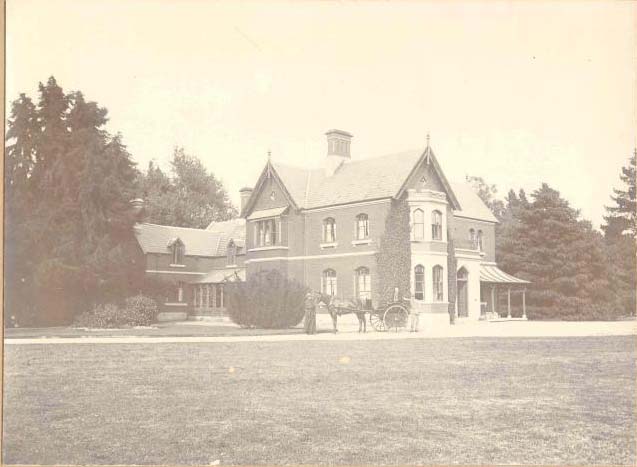This two-storey brick homestead was built in the early 1870s for a man many knew as 'Bully' White. Josiah Senior Woodhouse (1834-1905), or as he was more commonly known, Joseph Senior White, arrived in Canterbury from Australia and it was rumoured that he had been involved in some controversy there, which historian Pauline Wood suggests might have been the Eureka stockade incident, where goldminers revolting against the government were suppressed by armed troops. Other stories suggest that he was involved in a financial scandal or that he was a member of outlaw Ned Kelly's gang. Whatever the truth of these rumours White established became a successful businessman in New Zealand, and a noted local figure. He owned a number of businesses in Kaiapoi and Saltwater Creek including a chain of stores known as 'Beehive Emporiums' located throughout North Canterbury. White established his farm at Ohoka in 1867, planting around 100,000 exotic trees and erecting a brickmaking kiln, which produced the bricks for the homestead. He designed his house around an Australian homestead he particularly admired and hired Thomas Ayers and his sons, noted local bricklayers, to build Ohoka. The first part of Ohoka to be constructed was the service wing which housed kitchens, stables and other 'offices' grouped around a courtyard. This was completed by around 1870. The main two-storey block of the homestead was finished by 1872. Ohoka is Gothic in style with steeply pitched slate roofs, fretted bargeboards, finials and arched windows and has been compared stylistically with Victorian vicarages. Altogether the building consisted of twenty-two rooms and is an extremely early example of cavity brick construction in New Zealand. Cavity brick construction was developed to combat the problems with damp that brick walls were liable to suffer from. With this method two walls are built, an external and an internal one, divided by a gap of at least 50 millimetres and connected by metal ties. Drainage holes are left at the bottom of the external wall, and any moisture that seeps through the external wall drains out of the central space. This method of constructing brick walls was noted in Britain from the beginning of the nineteenth century, and was introduced to the United States from 1850. In both cases this method of construction did not become widely used until the early part of the twentieth century. The earliest noted use of cavity wall construction in Australia is 1870. In New Zealand 'Chadwell' at Kaiapoi is thought to be the earliest example of this method of construction, dating from 1865-1866. The number of early examples of cavity brick construction in North Canterbury are a result of one family of bricklayers, the Ayers, who.... Ohoka shows the esteem in which nineteenth-century landowners of Canterbury were viewed and how their large estates were aped by merchants and professionals, who often bought land after they had made their money in other areas. It is locally significant as the former house of a noted local personality. The homestead is important as one of the earliest buildings in New Zealand to be constructed using the cavity brick method of construction and is an important example of Ayers' work.


Location
List Entry Information
Overview
Detailed List Entry
Status
Listed
List Entry Status
Historic Place Category 1
Access
Private/No Public Access
List Number
274
Date Entered
4th April 1985
Date of Effect
4th April 1985
City/District Council
Waimakariri District
Region
Canterbury Region
Extent of List Entry
Extent includes part of the land described as Lot 1 DP 81869 (RT CB47B/270), Canterbury Land District and the building known as Ohoka Homestead thereon. Refer to the extent map tabled at the Heritage New Zealand Board meeting on 23 October 2014.
Legal description
Lot 1 DP 81869 (RT CB47B/270), Canterbury Land District
Related listings
Stay up to date with Heritage this month
